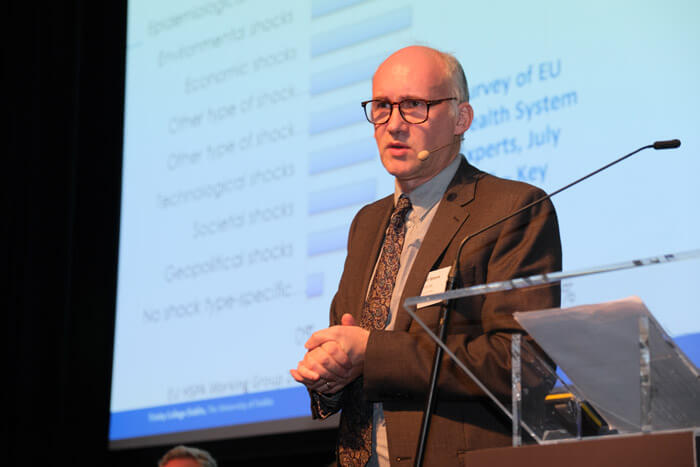
While shocks destabilised a health system they also opened up an opportunity for transformation and rather than putting a break on major reform, the Irish Government utilised the shock of COVID-19 to progress significantly its flagship health reform programme, Sláintecare and to advance universal healthcare, Prof. Steve Thomas, Edward Kennedy Professor of Health Policy and Management at Trinity College, Dublin and Principal Investigator, RESTORE project, told the Conference.
He said progress had been achieved through the development of new policies aligned to Sláintecare goals, backed up with massive funding and key innovations. In particular, the government introduced all COVID-19 related care and diagnostics without charges, implemented Independent Health Identifiers, adopted widespread telemedicine practice and developed new Sláintecare aligned contracts for hospitals, consultants, GPs and public health consultants, alongside beginning new recruitment into primary and community settings and opening new critical care beds.
There had been a shift in patterns and proportion of staffing going to acute and community levels and we might be getting hospital and acute staff to integrate into the community.
“Radical change can create a constructive legacy for the future but it must be sustained. It will be important to monitor the extent to which the new policies and enhanced budgets in Ireland will continue to translate into change on the ground.”
Prof. Thomas said the health services had gone into COVID following a period of austerity following the 2008 financial crisis. A survey of EU Health System Experts in July 2019, had shown a number of key concerns, as a result of the legacy of austerity. They wereepidemiological, environmental, economic, other type of shock (mainly on demand side), other kind of shock (mainly on supply side), economic shocks, societal shocks and geopolitical shocks.
Prof. Thomas said the legacy of austerity was:
- Top-down governance – lack of ownership and buy-in from those delivering care and a distrust of the decision-making agenda.
- Perceived value shift- a diminished view of the profession, apathetic and burnt-out.
- Powerless and detached -a resistance to change and conflict between front line workers and policy decision makers/management.
- Working the system (access) – strain on frontline workers, increased ER use but more stable health outcomes than originally predicted.
- Health-seeking behaviour change -led to reduction in primary care usage, increased emergency care, medication mismanagement and delayed treatment
Prof. Thomas said a review carried out by Trinity researchers on how international health system austerity responses to the 2008 financial crisis impacted health system and workforce resilience demonstrated how austerity-driven policy decisions could impact health systems when driven by the priorities of external agents. This created a real or perceived shift away from the values and interests of health professionals, a distrust in decision-making processes and resistance to change. Their values were at odds with the realities of implementing such policy decisions within sustained restrictive working conditions (rationing of staff, consumables, treatment options). A diminished view of the profession and an inability to provide high-quality, equitable, and needs-led care, alongside stagnant or degraded working conditions, led to moral distress. This could forge legacies that might adversely impact resilience when faced with future shocks.
He said the review revealed the importance of transparent, open communication, in addition to co-produced policies in order to avoid scenarios that could be detrimental to workforce and health system resilience. Looking at excess mortality due to the COVID pandemic, Ireland was about fourth from the top of the best countries, coming after Iceland, New Zealand and Australia. Those three countries came out on top and while there were problems in some nursing homes, by European standards, Ireland did quite well with very effective health service governance. Our legacy was more financing and revitalised reform. “Before COVID there was concern that health was taking up too much money and suddenly overnight with COVID, everybody got to realise that health was incredibly valuable and Cinderalla Healthcare was taken from the kitchen to the ballroom and wined and dined by Prince charming in the shape of the Department of Finance. Not only did we shove money towards COVID. but towards expanding the health system and revitalising the whole movement towards Sláintecare.
Prof. Thomas said that there were now fresh challenges facing the health services – the cost of living crisis, the workforce under more pressure, pent up demand from COVID era had not played through yet There were lessons o be learned from the economic shocks, – austerity must be contested and planning should be shared. While shocks could initially motivate the workforce, long shocks invariably produced turnover/leadership loss/increased workload and burnout.
“But workforce and waiting lists are two legacy issues which are very challenging, as are the total inpatient and day cases witing lists.
“There is also a sense of exhaustion and burnout among the workforce already exhausted from going through the economic crisis and we need to ensure that our health workforce remains intact . More care is needed now because many people did not go for treatment during COVID and a lot of elective care took a long time to get through the system. This has resulted in a pent up demand coming after COVID and the last thing you want is to be constraining money in the health sector at a time of high demand and high burnout when we have a cost of living crisis, partly a hangover form COVID and partly to do with the Ukraine war migration issues. putting our workforce under increasing pressure. My worry is that Cinderella will be going back to kitchen and there will be no more wining and dining with Finance. We must try and share decision making more with the workforce.”

